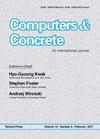Study on the performance of concrete-filled steel tube beam-column joints of new types
IF 3.3
4区 工程技术
Q2 COMPUTER SCIENCE, INTERDISCIPLINARY APPLICATIONS
引用次数: 0
Abstract
In this paper, the influence of axial compression ratio on the mechanical properties of new type joints of side span of rectangular concrete-filled steel tubular column-H-type steel beam is studied. Two new types of side-span joints of rectangular concrete-filled steel tubular column-H-type steel beam are designed and quasi-static tests of five new type joints with 1:2 scale reduction ratios are performed. The axial compression ratio of joint JD1 is 0.3, 0.4 and 0.5, and the axial compression ratio of joint JD2 is 0.3 and 0.5. In the joint test, different axial forces were applied to the top of the column according to different axial compression ratios, and low-cyclic reciprocating load was applied on the beam. The stress and strain distribution, beam and column deformation, limit state, failure process, failure mechanism, stiffness degradation, ductile deformation and energy dissipation capacity of the joint were measured and analyzed. The results show that: with the increase of axial compression ratio, the ultimate bearing capacity of the joint decreases slightly, the plastic deformation decreases, and the stiffness and ductility decrease. According to the energy dissipation curve of the specimen, the equivalent damping coefficient also increases with the increase of axial compression ratio in a certain range, indicating that the increase of axial compression ratio can improve the seismic performance of the joint to a certain extent. The finite element method is used to simulate the joint test, and the test results are in good agreement with the simulation results.新型钢管混凝土梁柱节点性能研究
本文研究了轴压比对矩形钢管混凝土柱- h型钢梁边跨新型节点力学性能的影响。设计了两种新型矩形钢管混凝土柱- h型钢梁边跨节点,并进行了5种新型节点1:2缩比的拟静力试验。节点JD1的轴压比分别为0.3、0.4、0.5,节点JD2的轴压比分别为0.3、0.5。联合试验中,柱顶按不同轴压比施加不同的轴向力,梁上施加低循环往复荷载。对节点的应力应变分布、梁柱变形、极限状态、破坏过程、破坏机制、刚度退化、延性变形和耗能能力进行了测量和分析。结果表明:随着轴压比的增大,节点极限承载力略有降低,塑性变形减小,刚度和延性降低;从试件的能量耗散曲线来看,等效阻尼系数在一定范围内也随轴压比的增大而增大,说明轴压比的增大可以在一定程度上改善节点的抗震性能。采用有限元法对联合试验进行模拟,试验结果与模拟结果吻合较好。
本文章由计算机程序翻译,如有差异,请以英文原文为准。
求助全文
约1分钟内获得全文
求助全文
来源期刊

Computers and Concrete
工程技术-材料科学:表征与测试
CiteScore
8.60
自引率
7.30%
发文量
0
审稿时长
13.5 months
期刊介绍:
Computers and Concrete is An International Journal that focuses on the computer applications in be considered suitable for publication in the journal.
The journal covers the topics related to computational mechanics of concrete and modeling of concrete structures including
plasticity
fracture mechanics
creep
thermo-mechanics
dynamic effects
reliability and safety concepts
automated design procedures
stochastic mechanics
performance under extreme conditions.
 求助内容:
求助内容: 应助结果提醒方式:
应助结果提醒方式:


